The rapid degradation of the Vembanad Lake has affected the lives and livelihoods of more than 8 million people in central Kerala.
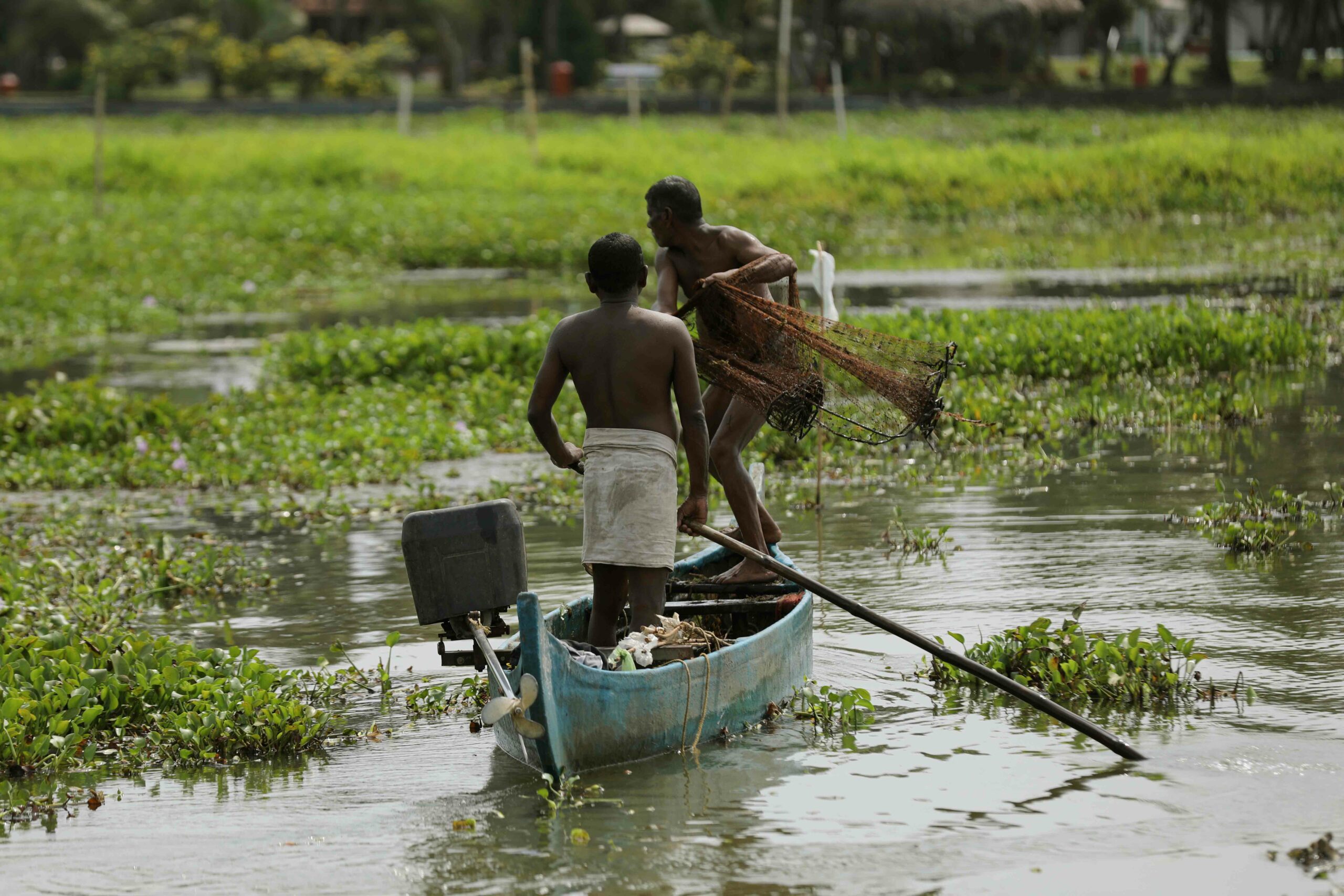
Traditional fishermen negotiate their way through a water hyacinth-choked portion of the Vembanad Lake at Kumarakom. (Shafeeq Thamarassery)
Houseboats sedately sailing through the tranquil brackish waters of the Vembanad Lake in lush-green Kerala provide a picture-postcard sight.
But, the mesmerising scenery diverts the attention from India’s longest lake’s attempt to whisper a grave tale — of its impending death.
Decades of sacrilegious negligence has led to its present condition, affecting the livelihood of those who depend on the water body.
The dying lake goes by three different names: It’s Vembanad Lake in Kottayam, Vaikom and Changanasserry; Punnamada in Alappuzha, Punnapra and Kuttanadu; and Kochi Lake in Ernakulam.
Illegal structures on its banks, discharge of effluents and sewerage were among the causes leading to the slow death of the Vembanad Lake, which hosts the internationally famed Nehru Trophy Boat Race.
The seven-star Kapico Resort was one of the illegal structures. The authorities are now busy demolishing it.
The Supreme Court has set a 28 March (Tuesday) deadline to demolish the entire resort complex in Nediyathuruthu, Alappuzha. The court issued the order after it found that the resort had violated the Coastal Zone Regulation (CRZ) Act.
The demolition drive is the culmination of a legal battle fish workers had waged for more than 15 years. The petitioners have now raised environmental concerns over the conventional manner in which the resort is being demolished.
“Most of the crucial structures of the illegal resort are yet to be demolished. On the other hand, the demolitions so far were conducted in a way causing severe damage to the fragile ecosystem of the Vembanad Lake,” AK Sailan, a leader of the fish workers, told South First.
“Eco-restoration must be the ultimate aim of demolishing such illegal ventures in the fragile wetland ecosystem. Here the conventional mode of razing down is causing more harm than rectification,” he said.
In its interim order on 21 March, the court expressed displeasure over the reluctance of the state government to dismantle the main structure of the ₹200-crore illegal tourist resort and warned the Kerala chief secretary, the state’s top bureaucrat, of contempt of court proceedings.
In the case of the scientific and environmental concerns raised by the fishers, the court directed the state to consider their anxieties and evolve a harmless method of demolishing the rest of the buildings.
As far as the Vembanad Lake — the second-largest wetland in the country and the largest tropical wetland ecosystem on the southwestern coast — is concerned, the illegal resort is just one of the numerous survival issues it faces.
A week ago, the principal bench of the National Green Tribunal (NGT) slapped a penalty of ₹10 crore on the state government for its failure in preventing the indiscriminate pollution of the Vembanad and Ashtamudi lakes in Kerala, listed as Ramsar sites.
A Ramsar site is a wetland area of international importance. These wetlands are protected under the strict guidelines of the Ramsar Convention on Wetlands. India currently has 75 Ramsar sites.
NGT chairperson Adarsh Kumar Goel stated in his order on 22 March that the penalty was in tandem with the “polluter pays principle”, and it has to be deposited in a ring-fenced account to be maintained under the authority of the state chief secretary.
The government must deposit the amount within 30 days and initiate corrective steps to protect the two Ramsar sites, hit mainly by encroachments and illegal waste dumping. The order also stated that the state’s remedial measures were inadequate.
Meanwhile, a detailed study by the Centre for Aquatic Resource Management and Conservation under Kerala’s University for Fisheries and Ocean Studies revealed that the whole wetland ecosystem of Vembanad has been severely degraded, dysfunctional and debilitated in recent years.
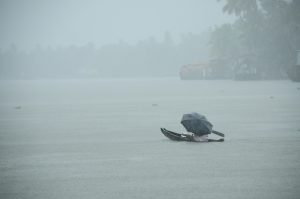
The rapid destruction of the lake is adversely affecting the lives and livelihoods of over eight million people in central Kerala. (File photo/South First)
The study, carried out over five years, also warned that the continuing destruction of Vembanad is adversely affecting the lives and livelihoods of over eight million people in the central Kerala districts of Alappuzha, Pathanamthitta, Kottayam and Ernakulam.
A copy of the comprehensive study accessed by South First revealed that anthropogenic and natural disturbances in the region led to the fast decline in the ecosystem.
The study asserted that a natural revival of the lake ecosystem is limited — and may not be possible. It recommended science and technology-based interventions to save it from further degradation.
Vembanad houses vast stretches of wetland areas, mainly including the unique Kuttanad polders — low-lying tracts of land that forms an artificial hydrological entity, enclosed by embankments — spread over 55,000 hectares. Most portions of the Kuttanad region are below sea level.
Kuttanad, located to the south of the Vembanad Lake, is known as The Rice Bowl of Kerala. It has the lowest altitude in India and is also one of the few places in the world where cultivation takes place below sea level.
The water-retention capacity of the lake has been reduced to an alarming rate of 85.3 percent, the study found. In 1990, it was 2,617.5 million cubic metres. In 2020, it dipped to 384.66 MCM.
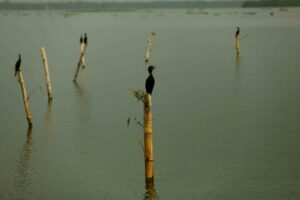
Cormorants rest on tree stumps in the lake at Muhamma in Alappuzha. The lake’s fish diversity is down by 40% from what it was in the 1980s. (Shafeeq Thamarassery)
The alarming depletion in the water-holding capacity is largely due to the significant reduction in the lake’s size — 365 sq km in 1900 to the present 206.30 sq km.
The whole riverine ecosystem of central Kerala is linked with Vembanad, as major rivers, Achankovil, Pampa, Manimala, and Meenachil empty into it.
Rivers Muvattupuzha, Periyar and Chalakudy also form a part of the wetland ecosystem, making it the lifeline of Kerala.
As per the study, in the south and central parts of Vembanad, the wetland system is facing alarming depth shrinkage. The average 8.5m depth in the 1930s has been reduced to the present average of 1.8m in the south and 2.87m at the lake’s centre.
Around 82 percent of the lake is less than two-metre deep, and 10.5 percent of its area has a depth ranging between two and three metres.
The study said the current fish diversity in the lake is 90 species, down 40 percent. As many as 150 species were reported in the 1980s.
The research also reported the presence of 30 different compounds of pesticides in the surface sediments in the south and central Vembanad Lake. These included organochlorine pollutants, organophosphate pollutants, urea derivatives (diuron), and other pesticides.
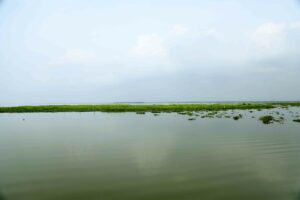
A study has found 30 different compounds of pesticides in the surface sediments in the south and central Vembanad Lake. (Shafeeq Thamarassery)
Though pollution levels are below the hazard levels set by the World Health Organisation, the presence of diuron, mainly in the central lake area, “is a cause for concern as it limits the growth of microalgal groups Chlorophyceae and Cyanophyceae, reduces the abundance of clams, and, therefore, has the potential to alter the trophic structure of the estuary”, the study noted.
Plastic pollution in the lake is much higher than reported in most estuaries worldwide.
The study estimated the presence of 3,005 tonnes dry weight of microplastics. It also found microplastic contamination on the body tissue of black clams collected from south and central Vembanad Lake.
The invasive mussel, locally called kallumekkai, appears to ingest more microplastics. Microplastic ingestion could reduce the growth rate of bivalve molluscs.
In most parts of the ecosystem, the water quality is abysmally low, and the level of coliform bacteria, very high.
Water hyacinths are choking the whole lake, its feeder canals and streams that once irrigated the riparian farmlands.
Flash floods, inundation, frequent droughts, and ecological degradation make survival difficult for the ecosystem.
To a large extent, flash floods and inundation issues could be mitigated by increasing the floodwater-holding capacity of the lake, experts said.
The fisheries university study recommended improving the discharge ability of Thottappally Spillway and restoring the filtration efficiency of Kuttanad polders on a priority basis.
According to VN Jayachandran of Kerala Sasthra Sahitya Parishad, indiscriminate houseboat tourism has also contributed to killing the whole ecosystem by emptying its garbage and other wastes into the backwaters.
KG Padmakumar, special officer and director of Kuttanad-based International Research and Training Centre for Below Sea Level Farming (IRTCBSF), said the cross-sectional area of rivers emptying into the lake has shrunk at several stretches due to large-scale encroachments of riverbanks and construction of bridges.
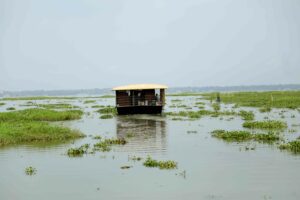
Discharges from the numerous houseboats and waste disposal by nearby local bodies have contributed to the present situation. (Shafeeq Thamarassery)
“Illegal buildings violating the CRZ Act and unregulated tourism are killing the Vembanad Lake. Now, local small-scale farmers and fish workers are falling victim to the degradation of the fragile ecosystem. We need remedial measures,” Charles George, president of Kerala Matsya Thozhilali Aikya Vedi, a fishers’ body, said.
“Discharges from the numerous houseboats and waste disposal by nearby local bodies have contributed immensely to the present deplorable situation,” he said.
“Soil erosion in the catchment areas of the rivers linked to the lake is also a major issue. Plastic wastes in large quantities can be seen floating on the backwaters, which were once clean and hygienic,” he pointed out.

Jul 26, 2024

Jul 26, 2024

Jul 26, 2024

Jul 25, 2024

Jul 25, 2024

Jul 25, 2024